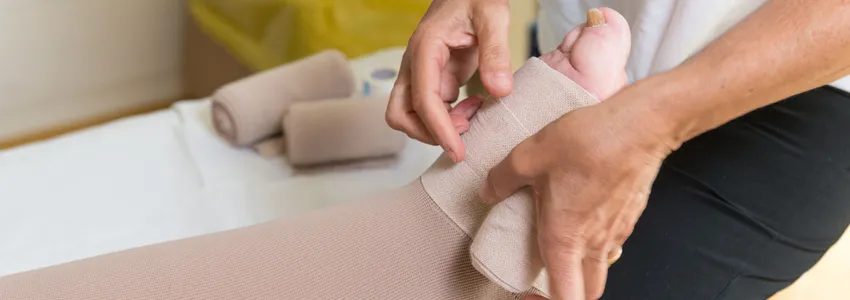
Photo by Valerio Pardi, Shutterstock: The lymphatic system drains fluids from the body’s tissues. When a lymphatic vessel is blocked, as is the case in lymphedema, fluid can get backed up into a limb, causing painful swelling.
Stanford Medicine News Center - June 22nd, 2016 - by Sarah C.P. Williams
Researchers at the School of Medicine have developed a possible treatment for lymphedema, the severe swelling of an arm or leg that can occur when the lymph system is blocked. Using scaffolding composed of specially patterned collagen nanofibers, the researchers coaxed lymph vessels to grow around lymph blockages.
The technique was effective at treating lymphedema in pigs, the scientists report in a study published online June 7 in Biomaterials.
“We were able to take a cue from nature about what molecules spur vessel growth, but also think outside the box and use this nanoscale scaffolding to bridge the blockages,” said Ngan Huang, PhD, assistant professor of cardiothoracic surgery and a co-senior author of the study. “I think combining the two was really key.”
A disease without a cure
The lymphatic system is responsible for draining fluids from the body’s tissues and filtering this lymph fluid. When a lymphatic vessel is blocked, as is the case in lymphedema, fluid can get backed up into a limb, causing painful swelling.
In developed countries including the United States, lymphedema is most often seen in cancer patients whose lymph nodes are affected by their cancer. But infections and genetic conditions can also cause lymph blockages. In some cases, the underlying cause of the disease — such as an infection — can be treated. But for many, physical therapy, massage and compression garments are the only options to treat the disease and provide just temporary relief.
“Lymphedema is a chronic, debilitating disease with profound functional and psychosocial implications,” said Stanley Rockson, MD, the Allan and Tina Neill Professor in Lymphatic Research and Medicine at Stanford and a co-senior author of the paper. “Current treatments are extremely limited. While transplantation of healthy lymph nodes represents a theoretically viable treatment option for cancer survivors and others, the success rate of these procedures has been disappointing.”
Nano-braids
Huang’s lab, in collaboration with the Union City, California-based company Fibralign, has been studying how nanofibers of collagen can be used in medicine. Collagen, the most abundant protein in the human body, acts as a structural support in a variety of tissues. The scientists have designed nanofibers, dubbed “BioBridge,” that mimic collagen’s different arrangements.
“The unique feature about the BioBridge scaffolds is that they’re not just noodles on a nanoscale,” said Huang. “They have patterning that’s physiologically relevant.” The scaffolds used in the recent work, she said, look like braided noodles, and mimic how collagen is naturally arranged in some connective tissues in the body. The threadlike fibers are each about a third of a millimeter wide.
Previously, Huang’s group has studied how the BioBridge nanofibers can be used to guide new blood vessels. As new cells that make up the vessels grow, they align themselves along the nanofibers. But lymph vessels, at a molecular level, are similar to blood vessels. So Huang and her collaborators wondered whether the fibers could also be used to coax and direct new lymph vessel growth as well.
Bridging lymph blockages
The scientists coated stretches of the BioBridge nanofibers with fragments of lymph nodes, since the nodes are known to produce molecules that stimulate new lymph vessel growth. Then, they surgically implanted the fibers around lymph blockages in pigs with lymphedema, building a stretch of fibers that bypassed each blockage like a bridge. After three months, the eight pigs that had received BioBridge scaffolding had 27 lymphatic collector vessels per square millimeter in the area around the implant, significantly more than the 1 lymphatic collector per square millimeter seen in control animals. Moreover, animals with the nanofibers had reduced fluid buildup in their limb affected by lymphedema.
“The sample size wasn’t as good as we would eventually like, but we followed these animals for a total of six months and got a lot of safety data,” said Huang. “There weren’t any adverse events.”
Moving to humans
So far, the BioBridge approach has only been tested in pigs. But Fibralign has a small clinical trial planned in Latin America, and Rockson is putting together a Stanford-based study to test the treatment in breast cancer patients with lymphedema.
The lead author of the paper is Catarina Hadamitzky, MD, of the Helios Clinic in Hildesheim Germany. The other co-senior author is John Cooke, MD, PhD, formerly a professor of medicine at Stanford who is now at the Houston Methodist Research Institute in Texas.
Other Stanford co-authors are former postdoctoral scholar Magdalena Bazalova-Carter, PhD; postdoctoral scholar Luqia Hou, PhD; research associate Yuka Matsuura; assistant professor of medicine Rajesh Dash, MD, PhD; and associate professor of medicine Phillip Yang, MD. They collaborated with researchers from the University of Victoria, Veterans Affairs Palo Alto Health Care System, Surpass Inc., IntraOp Medical Corp. and Fibralign Corp., which produces the aligned nanofibrillar collagen scaffolds used in this study. Hadamitzky and Cooke have received subscription rights in Fibralign.
The study was funded by the U.S. Army Medical Research & Materiel Command and the National Science Foundation.
Stanford’s Department of Cardiothoracic Surgery also supported the work.



